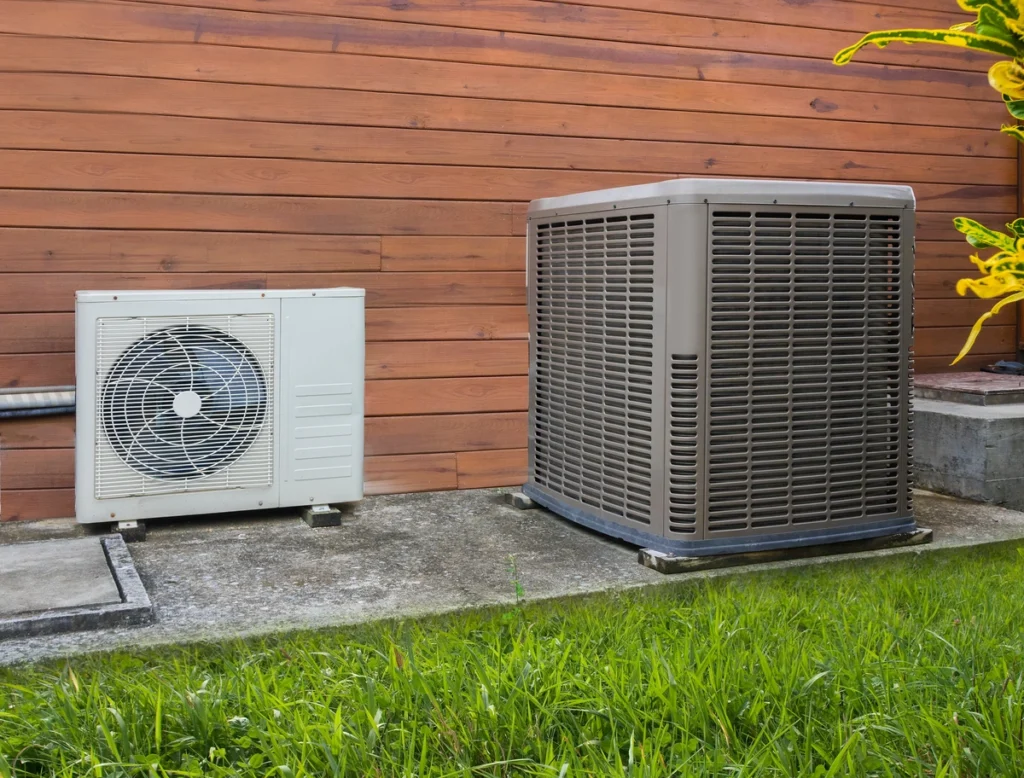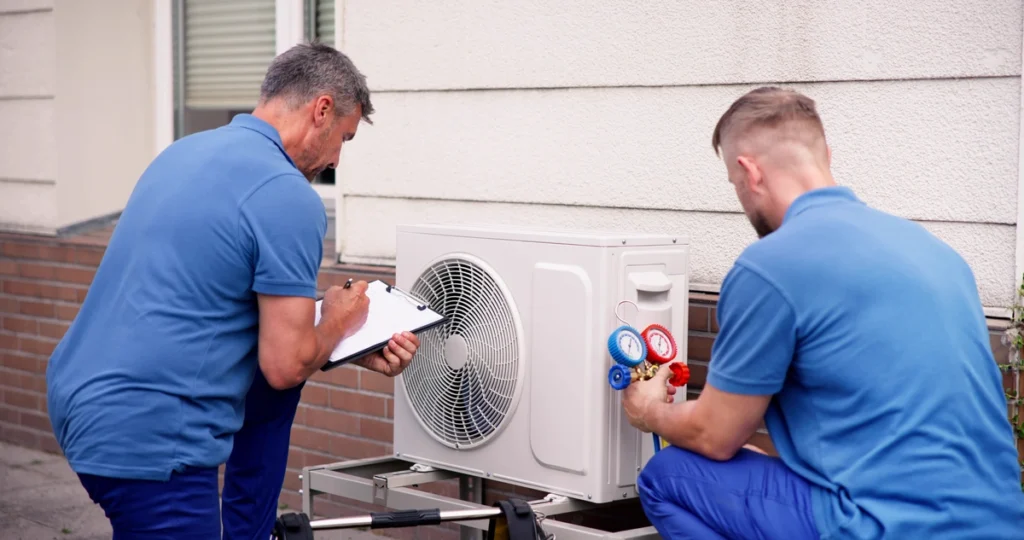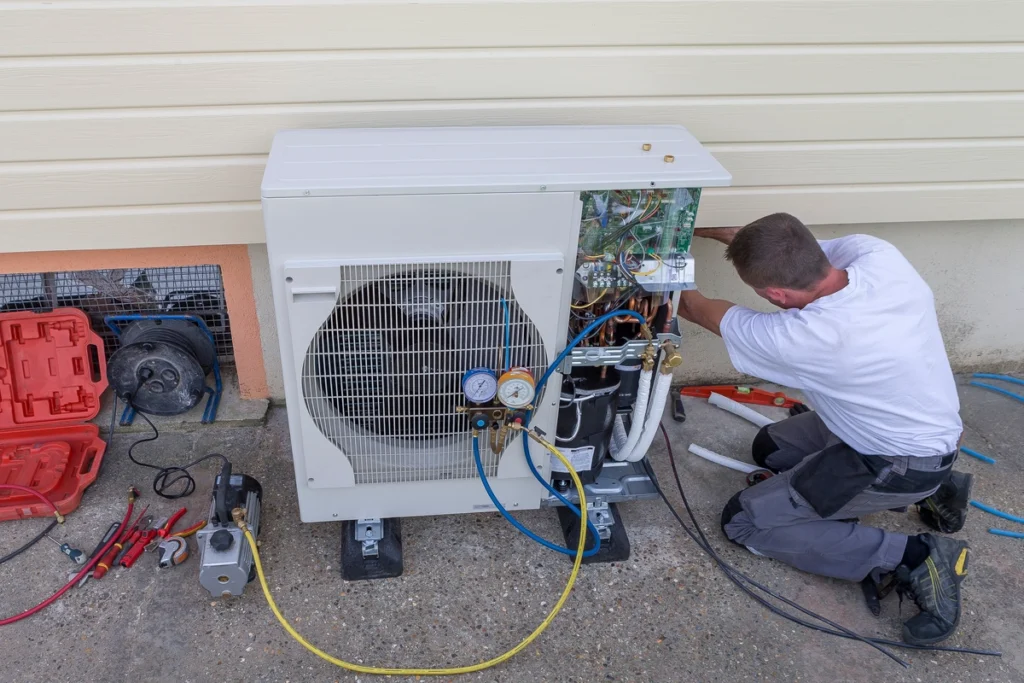In the realm of home comfort, few appliances are as indispensable as the heat pump. Whether you’re basking in the warmth of winter or seeking refuge from the summer heat, your heat pump works tirelessly to regulate your home’s temperature.
However, like any mechanical system, it requires regular maintenance to function optimally. In this guide, we’ll delve into the world of heat pump maintenance, exploring:
- What heat pumps are
- Why maintenance is crucial
- How to maintain them
- Signs indicating the need for professional repair
- The associated costs
- The lifespan of these essential devices
What is a Heat Pump?

Before diving into maintenance, let’s understand what a heat pump is and how it operates. In essence, a heat pump is a device that transfers heat from one location to another, typically between indoor and outdoor environments. It functions similarly to an air conditioner but with the added capability of heating your home during colder months.
During winter, a heat pump extracts heat from the outdoor air and transfers it indoors to warm your home. Conversely, in summer, it removes heat from indoor air and expels it outside, thereby cooling your living spaces. This dual functionality makes heat pumps highly efficient and versatile, offering year-round comfort with reduced energy consumption compared to traditional heating and cooling systems.
Why Heat Pump Maintenance Is Important
Maintaining your heat pump is vital for several reasons:
- Efficiency: Regular maintenance ensures that your heat pump operates at peak efficiency, minimizing energy consumption and lowering utility bills.
- Reliability: Proper maintenance reduces the likelihood of breakdowns and extends the lifespan of your heat pump, providing reliable comfort throughout the year.
- Air Quality: Clean filters and coils contribute to better indoor air quality by trapping dust, allergens, and pollutants, preventing them from circulating in your home.
- Warranty Compliance: Many heat pump manufacturers require proof of regular maintenance to uphold warranty coverage. Neglecting maintenance could void your warranty, leading to costly repairs or replacements.

How to Maintain Your Heat Pump in 7 Steps
Now that we understand the importance of maintenance, let’s explore how to keep your heat pump in top condition. Here are some essential maintenance tasks:
1) Clean or Replace Air Filters:
Dirty filters restrict airflow, reducing efficiency and putting strain on the system. Clean or replace filters every one to three months, depending on usage.
2) Check and Clean Coils:
Inspect the outdoor and indoor coils for dirt, debris, and grime buildup. Use a soft brush or vacuum to remove any obstructions, ensuring optimal heat transfer.
3) Clear Debris:
Regularly remove leaves, branches, and other debris from around the outdoor unit to prevent airflow blockages and maintain proper ventilation.
4) Inspect Thermostat:
Verify that the thermostat is functioning correctly and calibrated accurately. Replace batteries if necessary and consider upgrading to a programmable or smart thermostat for enhanced control and energy savings.
5) Lubricate Moving Parts:
Lubricate motors, bearings, and other moving parts according to manufacturer guidelines to reduce friction and extend component lifespan.
6) Check Refrigerant Levels:
Insufficient or excessive refrigerant can affect heat pump performance. If you suspect a refrigerant leak or imbalance, contact a professional technician for inspection and repair.
7) Schedule Professional Maintenance:
While many maintenance tasks can be performed by homeowners, it’s advisable to schedule annual professional maintenance with a licensed HVAC technician. They can perform comprehensive inspections, identify potential issues, and ensure optimal performance and efficiency.
Signs That You Need Professional Heat Pump Repair
Despite regular maintenance, heat pumps may encounter problems requiring professional repair. Here are some common signs to watch out for:
- Reduced Heating or Cooling Efficiency: If your heat pump struggles to maintain desired temperatures or takes longer to heat or cool your home, it may indicate underlying issues such as refrigerant leaks, compressor problems, or airflow restrictions.
- Strange Noises: Unusual sounds like grinding, squealing, or banging noises could signify mechanical issues, worn-out components, or loose parts within the system.
- Cycling On and Off Frequently: Rapid cycling or short-cycling can indicate various issues, including thermostat problems, refrigerant leaks, or inadequate airflow, all of which require professional attention.
- Ice Buildup: Frost or ice accumulation on the outdoor unit during winter or on the indoor coils during summer suggests airflow problems, refrigerant issues, or malfunctioning defrost controls.
- Water Leaks: Moisture or water pooling around the indoor or outdoor unit may indicate leaking refrigerant, clogged drain lines, or condensate pump failure, requiring prompt repair to prevent water damage and mold growth.

Cost of Heat Pump Repair
The cost of heat pump repair can vary depending on the nature and severity of the problem, as well as factors such as labor rates and replacement parts. Minor repairs such as replacing a faulty thermostat or cleaning coils may cost a few hundred dollars, while major repairs such as compressor replacement or refrigerant leak repair could range from $1,000 to $2,500 or more.
It’s essential to address issues promptly to prevent further damage and minimize repair costs. Additionally, investing in regular maintenance can help prevent costly repairs by identifying and resolving minor issues before they escalate into major problems.
How Long Your Heat Pump Will Last
The lifespan of a heat pump depends on various factors, including usage patterns, maintenance frequency, and environmental conditions. On average, a well-maintained heat pump can last 10 to 15 years or more. However, factors such as heavy usage, extreme temperatures, and neglecting maintenance can shorten its lifespan.
To maximize the longevity of your heat pump, adhere to a regular maintenance schedule, promptly address any issues, and consider upgrading to a more energy-efficient model when it’s time for replacement.
Schedule Your Preventative Maintenance
Your heat pump plays a crucial role in maintaining a comfortable indoor environment year-round. By prioritizing regular maintenance and promptly addressing any issues that arise, you can ensure optimal performance, efficiency, and longevity of your heat pump. Remember to perform basic maintenance tasks regularly, watch for signs indicating the need for professional repair, and invest in professional maintenance to keep your heat pump running smoothly for years to come.
Reach out to the team at Palmetto today to get the help you need!
